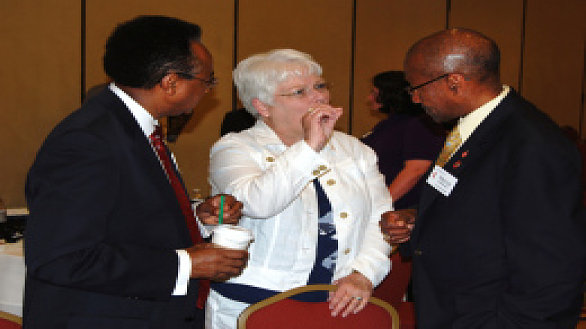Photo Left to right, Bishops James R. King, Mary VirginiaTaylor and Marcus Matthews converse during a break at the Connectional Table meeting
By Rich Peck
NASHVILLE, Tenn. (UMNS) –– Members of the Connectional Table, meeting May 9-11, suggested drivers of the Interim Operations Team should proceed cautiously through intersections within The United Methodist Church.
The team is considering seven structural changes team members hope will increase the number of vital congregations as the result of findings by the former Call to Action team. Team members asked the Connectional Table to respond to seven proposals with a green, yellow or red traffic light.
Forty-one members of the 60-member Connectional Table responded.
Proposal 1 –– Change apportionment system
At present, the General Council on Finance and Administration determines the amount to be apportioned to each annual conference based a formula that includes expenditures of conference churches and per-capita income weighted by the average attendance in each county within the conference.
Both the Interim Operations Team and an apportionment study group recommend changing that system for an “income-based proportional giving system,” which in its simplest form simply asks churches to pay a percentage of their total giving.
This was clearly the most popular proposal. Fifty-four percent of the respondents gave a “green light” to the simplified formula and only 24 percent asked the group to stop efforts to implement the plan.
Proposal 2 –– Fee-for-service plan
At present, churchwide general agencies are supported by World Service, the largest of the seven general church apportionments. Most goods and services are provided to local churches and annual conference at no additional cost.
The team is considering a plan that would replace apportioned funds from some reconfigured general agencies with a fee-for-services plan. Neil Alexander, president of the United Methodist Publishing House and a team member, says some agencies already provide resources for money. When members asked what happens to churches that cannot afford the service, they were assured most requests would come from and be paid by annual conferences.
Despite such assurances, only 23 percent of respondents gave a green light to the proposal. Thirty-six percent gave the idea a yellow light and 41 percent said their light was red.
Proposal 3 –– Set-aside bishop
At present, every bishop presides over a geographic area and serves part time as officers and members of churchwide agencies. A retired bishop serves as the ecumenical officer working with the United Methodist Commission on Christian Unity and Interreligious Concerns.
The commission and the council are proposing that one of the active bishops serve as the ecumenical officer of the council without presiding over a geographic area. This bishop also would help implement Call to Action recommendations and focus on growing vital congregations.
Some members wondered if the plan would provide more power to the bishops than to the annual conferences. Others suggested that if the bishop were to represent the denomination at U.S. ecumenical meetings, only a U.S. bishop would qualify for the post.
Thirty-nine percent of the respondents gave a green light to the proposal. Only 13 percent asked the team to proceed with caution.
Proposal 4 –– Connectional Ministries Board
At present, the 60-member Connectional Ministries team coordinates the work of the churchwide agencies. Members include officers and staff of general agencies and representatives of caucuses, jurisdictions, youth and young adults.
The team is proposing the creation of a 13-member Connectional Ministries Team to coordinate the work of churchwide units. Twelve members would be elected by General Conference, the denomination’s top lawmaking body, to serve on the board along with the set-aside bishop.
Some members question whether General Conference will elect people with the expertise needed. Others questioned how young people and people from outside the United States would be guaranteed places at the table.
Forty-three percent of the Connectional Table members said the Interim Operation Team should be cautious in proceeding. Equal numbers of 28.5 percent had red and green lights.
Proposal 5 –– Advisory panels
At present, there are 13 general church agencies governed by boards composed of people from around the world. Meeting cost for these face-to-face annual or semi-annual gatherings can be expensive.
The team is suggesting the number of agencies be reduced and, in some cases, be replaced by advisory panels that might meet only by electronic means.
Some Connectional Table members suggested that serving as advisors is not truly representational.
The group was somewhat cautious about the proposal with only 32.4 percent giving the plan a green light and 43.2 percent saying their light was yellow.
Proposal 6 –– Two-year transition
A proposal to allow the 12-member Connectional Ministries Board to oversee a two-year transition to a new configuration of general agencies received an equal 36.5 percentage of green and caution lights.
Proposal 7 –– Fewer fund categories
Finally, 44 percent of respondents agreed the 2013-16 budget should stay the same to ease transition under the control of the Connectional Ministries Board and with fewer fund categories, all explicitly directed to the four areas of focus of the denomination.


